HomeFeatures
After three hours of Bloober’s Silent Hill 2, it’s unclear who is remaking whoPeeling apart the pieces of auld and nu-Hill
Peeling apart the pieces of auld and nu-Hill
Image credit:Konami
Image credit:Konami
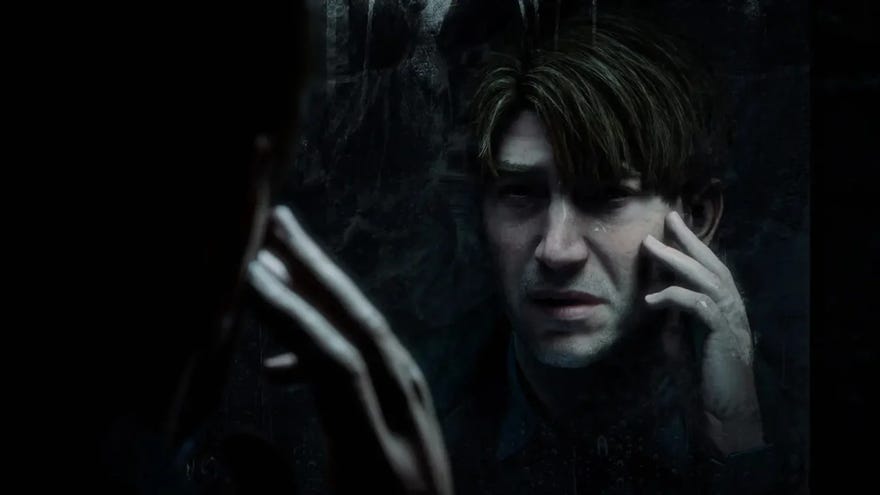
It begins with your character, James Sunderland, descending from the road towards the eponymous Midwestern nowhere-town. Like many games of the period, Silent Hill 2 uses a third-person, over-the-shoulder manual camera, which allows you to glance fearfully up at the monstrous pine trees that fringe the path - each rising from a bulging tide of fog that menaces with the suggestion of approaching figures. There is moisture everywhere, gushing from drain pipes and dribbling down concrete barriers. As you amble into the murk, deathly chords and groaning, unmechanical motifs reverberate from somewhere deep underground.
Silent Hill 2 - Story Trailer | PS5 GamesWatch on YouTube
Silent Hill 2 - Story Trailer | PS5 Games

On the whole, Bloober’s Silent Hill 2 sometimes seems more… visually led than it should. There’s an innocent airiness and spaciousness to it, for all the shadows and grime, with puddles that grandly reflect the clouds and sumptuously imagined interiors that speak to an antiquated fixation with extravagant lighting effects and photorealistic fine-detailing for its own sake.
Image credit:Konami
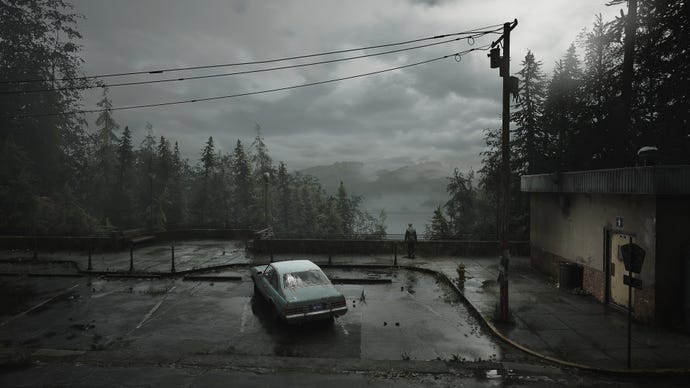
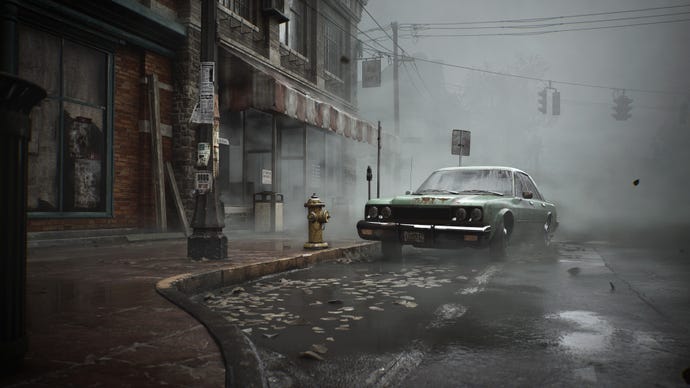
There are pitch-black corridors to navigate, but the world seldom feels wholly obscure and mazelike, the way you sense it wishes to - the nearest it gets, in the first three hours, is during a visit to an apartment complex, which is spread across three floors' worth of blocked routes and secrets. The manual camera also makes it easy to spot and avoid the game’s early monsters, the Lying Figures - tottering pus-bags sewn into effete straitjackets of purple flesh, some of them prone beneath parked cars. Subsequent, four-legged marionettes are harder to evade. You’ll often find them in blindspots, posing behind entrances, with another creature or spotlit object to distract you in the middle of the room.
Junking the over-the-shoulder camera, it gives you a landscape frayed to chunks that are explored using a blend of fixed and on-rails perspectives. The opening descent now begins with the view facing towards James, provocatively hiding the forest. The camera spins around soon after, but there is little to see. The forest has been gutted, simplified to pillars canting from fog that now pours toward you like ashen surf, as though trying to shove you away.
In place of the Bloober game’s archaic Unreal showiness, Team Silent offer up purposefully crude outlines and bruised pixelation representative ofmore recent trends in video game art direction and graphics. The sense of disorder now extends to your understanding of the software; the textures are scars in the simulation itself. With visual detail eliminated, the sound effects are also more pointed: you’ll hear shambling footsteps that radiate from nowhere, as though they’re coming from behind your eyes. It’s a striking revising and reducing of Bloober’s fable, although sometimes, I think, Team Silent’s erasures go too far. The detour into the garage with the poster has been removed to keep the focus on the descent, for example, at the cost of some useful foreshadowing.
Silent Hill 2 - Part 1 Walkthrough Gameplay No CommentaryWatch on YouTube
Silent Hill 2 - Part 1 Walkthrough Gameplay No Commentary

And then there’s the combat. In both the old and new Silent Hill 2, it’s something to endure. James is a regular bloke out of water, amassing a small arsenal of improvised spiked bats and a couple of guns, for which you’ll seldom have enough ammunition. The point is never to overpower - and certainly never to farm foes for crafting materials or XP, as in other less well-preserved games of the period, likeDiablo 4- but Bloober try to cultivate a sense of growing mastery. Their comparatively rugged version of James is equipped with a lateral dodge and a quick-turn for deft evasion and fallback manoeuvres. The over-the-shoulder perspective allows for easy measuring of engagement distance, and there are discrete, context-sensitive animations that glamorise the bludgeoning and instil a sense of frenzy.
Team Silent’s game deletes these flourishes. Cramped camera perspectives coupled with disruptively “tanky” turntable movement puts greater pressure on the player, and there are no dramatic wind-ups and followthroughs to spike the endorphins. The Japanese studio also has less patience for stagy build-up or pedagogical due process. The first time you meet one of those Lying Figures in Bloober’s game, for example, it’s after a drawn-out flirtation of pursuing it between backyards, crawling into a garage, and recovering the aforesaid radio from a chair, only for the monster to burst through the wall behind you. If there’s a sense of mounting threat, there’s also a sense of being shown the ropes, with tooltips punctuating the dread. It’s a reminder that in Bloober’s heyday, even horror games were focus-tested to the extreme to minimise uncertainty: there was less trust in the player’s ability to find their way.
In Team Silent’s reworking, you merely follow the wobbling entity through the fog to a barricaded tunnelmouth, and the camera awkwardly captures the ensuing struggle from inside the tunnel. It feels unglamorous, indistinct, unvideogamey. I do admire Bloober’s approach to combat encounters for the line it treads between rewarding dexterity and making you feel overwhelmed, but here as elsewhere, it feels like Team Silent have cut to the heart of the ancient masterwork, and dragged forth an aesthetic of powerful negation it wasn’t quite able to realise with the techniques and technology of its time.
Image credit:Konami
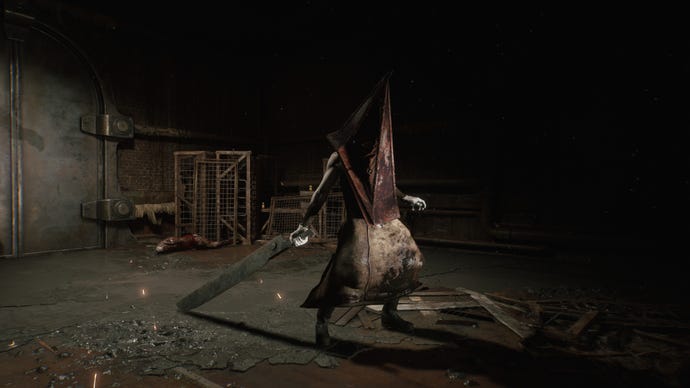
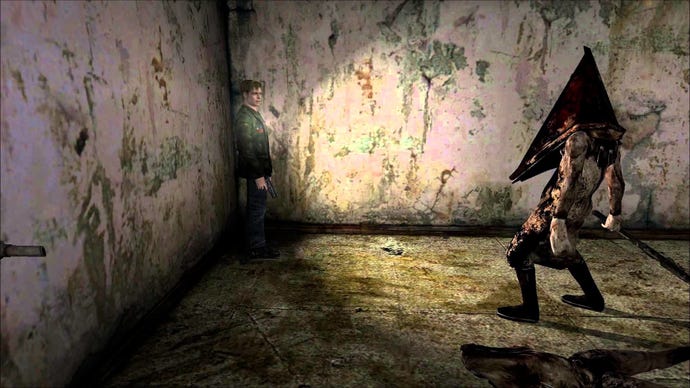
I think it’s a useful thought experiment to flip the poles and portray the Remake as the outmoded classic, in need of restoration, but it’s also thematically appropriate. Because Silent Hill knows a thing or two about burying the past. It knows that you can’t. The past is always present, however spurned. It’s entangled with the consciousness much as the town’s rusty, seeping Otherworld inhabits the geometry of its everyday self. The past’s “pastness”, its air of monstrous decay, is a product of the desire to deny it. James Sunderland, specifically, is so much in denial about his wife’s death that he has become a mobile singularity, his surroundings a scraping, shrieking distortion of what he refuses to see.
Silent Hill is happy to accommodate James’s delusions. Again, the town is a multitude of mirrors, a kaleidoscope of doppelgangers and projections, mashed into a thick pop-historical sediment of occult devices and abuses. It reconfigures to fit the tormented psyche of every fresh protagonist and every non-player resident, bringing their demons to life. As such, it’s incorrect to suggest that you ever visit Silent Hill “for the first time”: the point of going to Silent Hill is realising that you’re already there, trying to leave. To officially “remake” a Silent Hill game, therefore, is to fall prey to a basic bit of narrative irony, and inadvertently portray remaking video games as psychological repression carried out at industrial scale. Or possibly, it’s to embrace these things.
Image credit:Konami

Bloober have been living in Silent Hill for a while, putting down roots. From the unspoken multiple endings ofLayers Of Fearto the cyberpunk apartment complex ofObserver, they’ve deployed Silent Hillian devices to investigate their own heritage as Polish developers, negotiating their own present in a landscape of wounds and looming, anxious futures.
This isn’t to say that Bloober’s games have no being without Silent Hill: they are their own, substantial worlds, born of many inspirations. Nonetheless, Bloober making a Silent Hill game has the weight of inevitability. It’s as though you’d shuffled through a crawlspace inThe Mediumand emerged into the wavering light of Neely’s Bar. I think it’s fun and possibly helpful to characterise Bloober as one of the lost souls caught in Silent Hill’s web. What could they be in denial about? Definitely not the undying appeal of tank controls and fixed perspectives.
There is so much to say about how the old and new games speak to each other - and this, for me, is the only thing that makes the remaking craze worthwhile. Come at it with the right mistrust toward the rhetoric of technological rebirth, and you get to see different generations of game-makers in dialogue, like stars at varying distances forming a flat constellation, excavating a shape from the darkness. I say “excavating a shape”, but in this case, of course, the stars are framing a hole. It’s gone now.